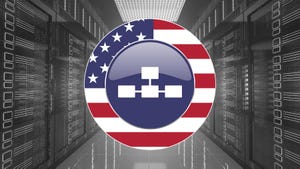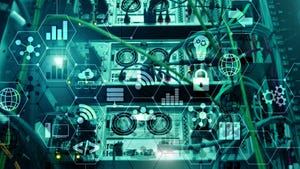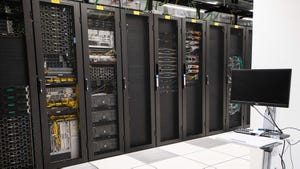Data Center Emissions: Virginia, Texas, California Top CO2 ChartData Center Emissions: Virginia, Texas, California Top CO2 Chart
Virginia, Texas, and California lead the US in data center emissions, according to a new report.

Virginia, Texas, and California are the US states most impacted by data center emissions, with Virginia leading by a significant margin, according to a new report.
The study from web hosting provider KnownHost examined the carbon dioxide equivalent (CO2-eq) emissions per megawatt-hour (MWh) from data centers across the US.
Perhaps unsurprisingly given its status as a global digital infrastructure hub, Virginia’s data centers produce an estimated 199.1 tons of CO2-eq per MWh – over one-seventh of the total US data center emissions.
The report noted the state’s role as a major technology center, driven by a reliable power supply and low costs, contributes to its high emissions levels.
Texas, ranked second, emits an estimated 71.25 tons of CO2-eq across 278 data centers, followed by California with 116.7 tons of CO2-eq.
Ohio and Illinois rounded out the top five, with 65.6 tons and 63.7 tons of CO2-eq, respectively.

Visualizing the impact: Data center emissions are highest in Virginia, Texas, and California (Image: KnownHost)
Data Center Carbon Reduction Strategies
Daniel Pearson, CEO at KnownHost, said companies are increasingly aware of the environmental concerns tied to data center expansion and are adopting various strategies to reduce their carbon footprints.
One report that surveyed 500 medium to large businesses in the US found 92% of businesses view reducing carbon emissions as an “urgent” priority for their organization.
“These initiatives could include shifting towards renewable energy sources, improving the energy efficiency of facilities, or investing in carbon credits,” Pearson said.
He added there is a push to design data centers that incorporate green technologies, such as using liquid cooling systems to reduce water consumption and energy use.
“However, the challenge of significantly reducing emissions remains, especially with the projected demand for data centers,” Pearson said.
Richard Clifford, director of solutions at Keysource, a data center and infrastructure design consultancy, warned that increasing power demands from data centers, particularly in states like Virginia and Texas, are placing added strain on the decentralized US energy grid.
“In these states, the growth of data centers intensifies localized demand surges, complicating efforts to maintain grid stability,” he said.
To address this, solutions such as demand response programs can encourage data centers to reduce power usage during peak times, alleviating pressure on the grid.
“Ultimately, collaboration between private energy providers, regulators, and policymakers is essential for managing the long-term sustainability of the grid,” Clifford said.
He noted companies including Google and Microsoft are tackling environmental concerns related to their expanding data centers through substantial investments in renewable energy projects.
A ‘Multi-Pronged Approach’ to Data Center Sustainability
Steve Lim senior vice president of marketing and product at NTT Global Data Centers, said data centers should continue to investigate alternative sources of power as well as ways to improve efficiency of how power is used inside data centers.
“Renewable energy solutions are better for the environment and put less strain on the grid overall,” he said. “States can watch and learn from each other to become more sustainable, including ways to implement energy efficient techniques and reduce our carbon footprints.”
Pearson said the challenge in Virginia is substantial due to its large concentration of data centers and the continued influx of investment, including Google’s multibillion-dollar expansion in the state.
“The sheer scale of operations requires a substantial amount of electricity, much of which comes from traditional, carbon-intensive sources,” he explained.
Pearson said that to balance growth with sustainability, there needs to be greater investment in clean energy infrastructure, including wind and solar power.
“Many states have offered tax breaks for data centers however, these have recently come under scrutiny,” he said, noting some lawmakers have proposed attaching strings to data center tax breaks to require them to maximize energy efficiency and use renewable resources.
Renewable energy sources like hydropower, solar, and wind have the potential to play a pivotal role in reducing the carbon footprint of data centers by providing low-carbon alternatives to traditional power generation.
Pearson pointed to Greensparc’s data center in Alaska, which operates entirely on hydropower, as evidence of the potential of these green energy solutions to power large-scale operations sustainably.
“However, scalability remains a challenge,” he said.
Read more of the latest data center sustainability news
Clifford said states should be looking at a multi-pronged approach, combining a mix of regulatory, financial, and infrastructural strategies.
“They can look to implement stricter sustainability regulations such as emissions reduction targets which compel businesses and data center operators to use renewable energy sources as a priority,” he said.
Additionally, states can offer tax incentives and grants for data centers that adopt energy-efficient technologies, such as advanced cooling systems and optimized energy management software, helping lower energy consumption.
Clifford said strategically siting data centers near renewable energy sources like wind and solar farms – which can be done through building regulations – can also help optimize the carbon footprint of a data center.
Renewables Emerge as the Grid is Strained
While states like Alaska, which uses hydropower for more than 20% of its energy, can feasibly use such renewable energy, other states may struggle due to geographic and environmental limitations.
Andy Cvengros, managing director of data center markets for JLL, noted that among the three states whose data centers produce the most carbon dioxide – Virginia, Texas, and California – Texas and California use power sources including natural gas and coal which are carbon-positive.
However, Texas regulators are considering stipulations requiring data center operators to build their own power plants as the state’s grid comes under increasing strain.
“You’re seeing very big issues in California with regards to power availability with Pacific Gas and Electric Company and Silicon Valley Power unable to support any more data centers until 2030 or 2035,” he said.
As tech companies push towards carbon-neutral operations, nuclear energy is emerging as a reliable source to power large-scale data centers, Cvengros explained.
He noted that the shift is already evident with actions from major players including Microsoft bringing the Three Mile Island facility back online.
Amazon has followed suit by acquiring the talent needed to support nuclear-powered operations.
The move towards nuclear power is driven by its capacity to generate massive amounts of electricity compared to traditional sources like coal or natural gas.
“You see more and more reliance on nuclear as the source of power that can support these data center needs,” Cvengros said.
For these companies, nuclear power not only aligns with their carbon-neutral goals, but also ensures the generation of gigawatts of energy, critical for maintaining large-scale operations.
In parallel, advancements in AI and chip technology are playing a crucial role in optimizing energy use within data centers.
“You’re going to see AI more utilized within the data center footprints to analyze operations,” Cvengros said.
Companies like Nvidia are developing more energy-efficient chips, with the latest models consuming 25% less power.
The shift isn’t solely about going green – it’s about addressing the growing concern of power shortages.
“There’s absolutely a focus on this for various reasons, not necessarily just green, but because we’re running out of power as a country,” Cvengros said.
About the Author
You May Also Like
.webp?width=100&auto=webp&quality=80&disable=upscale)
.webp?width=400&auto=webp&quality=80&disable=upscale)







